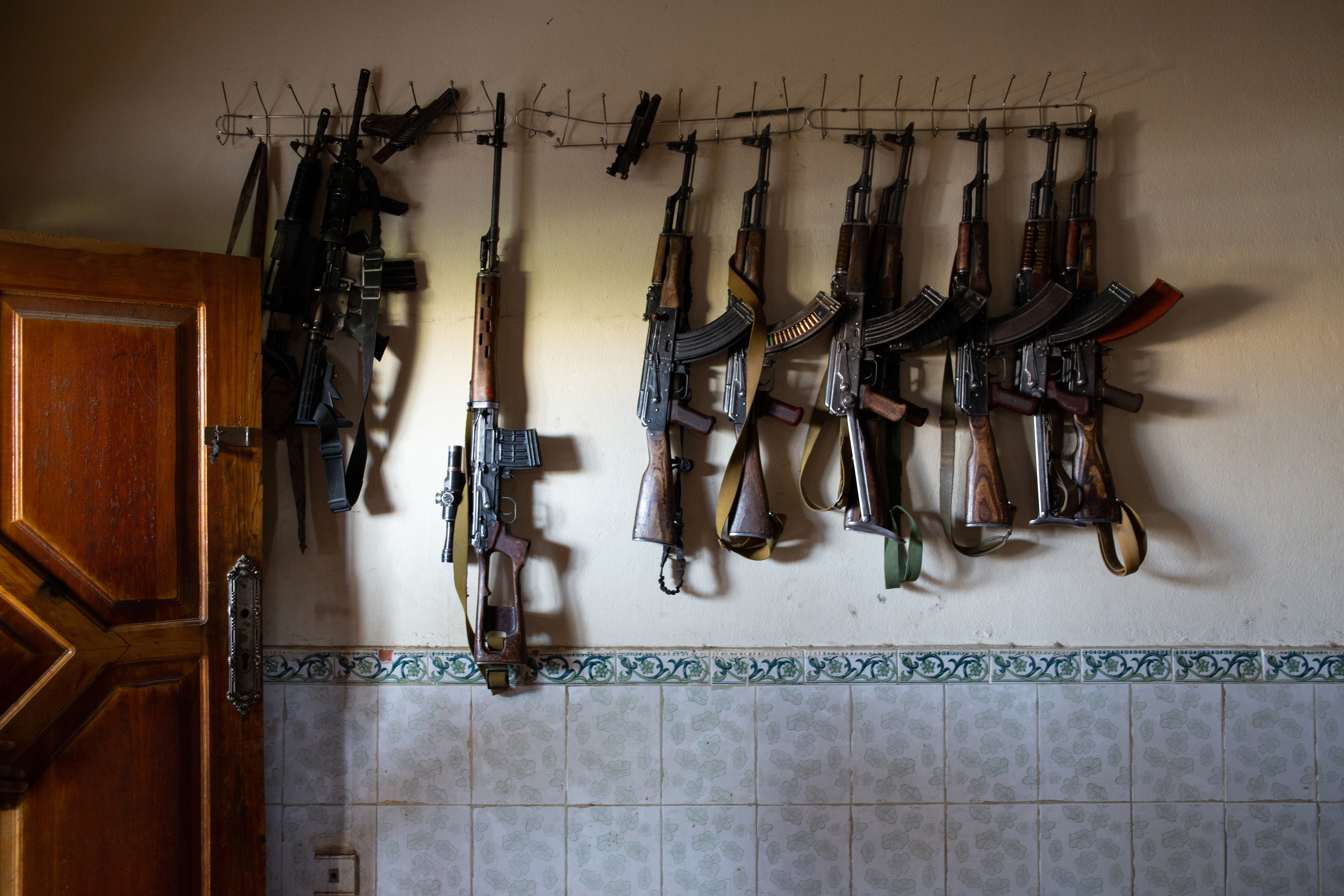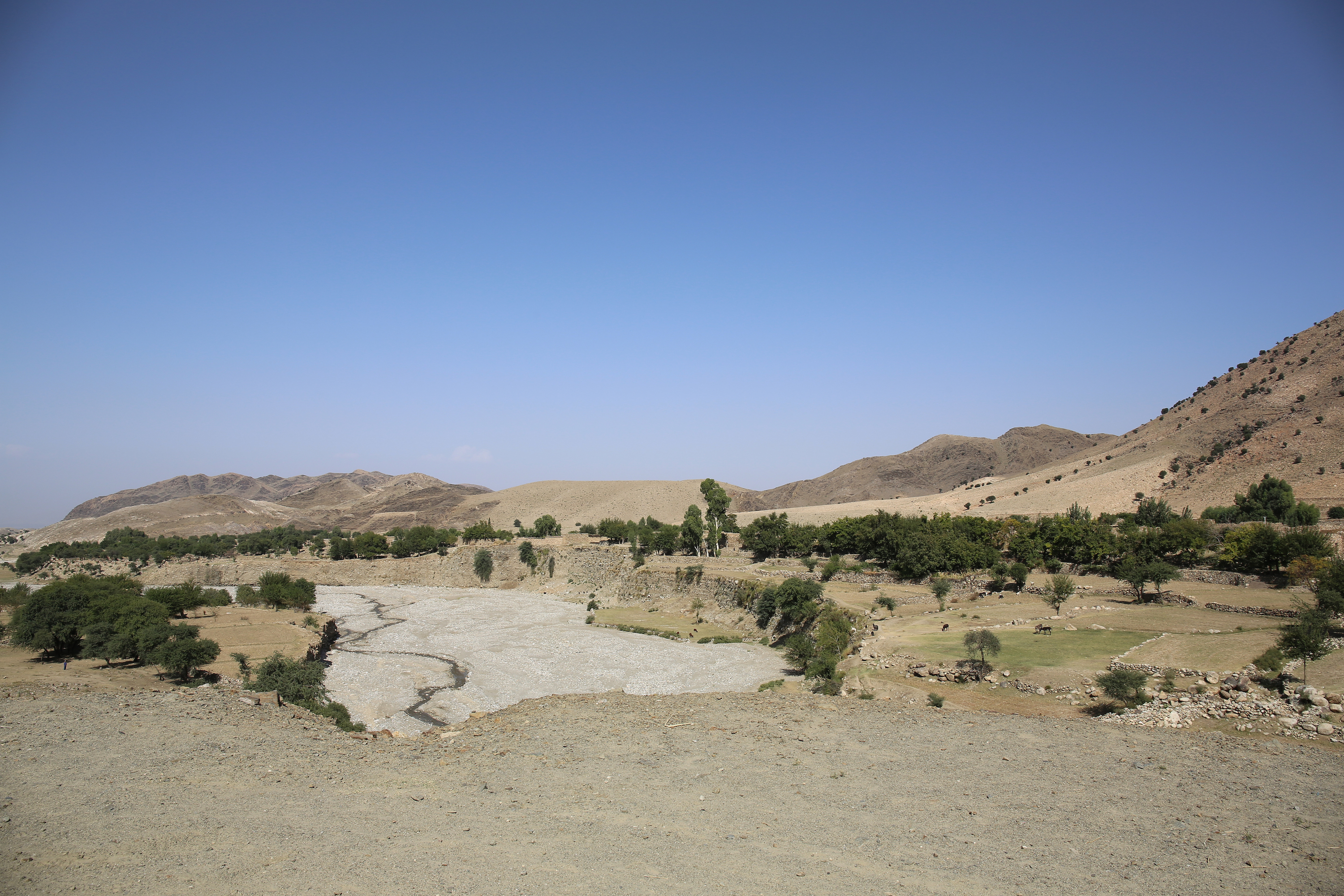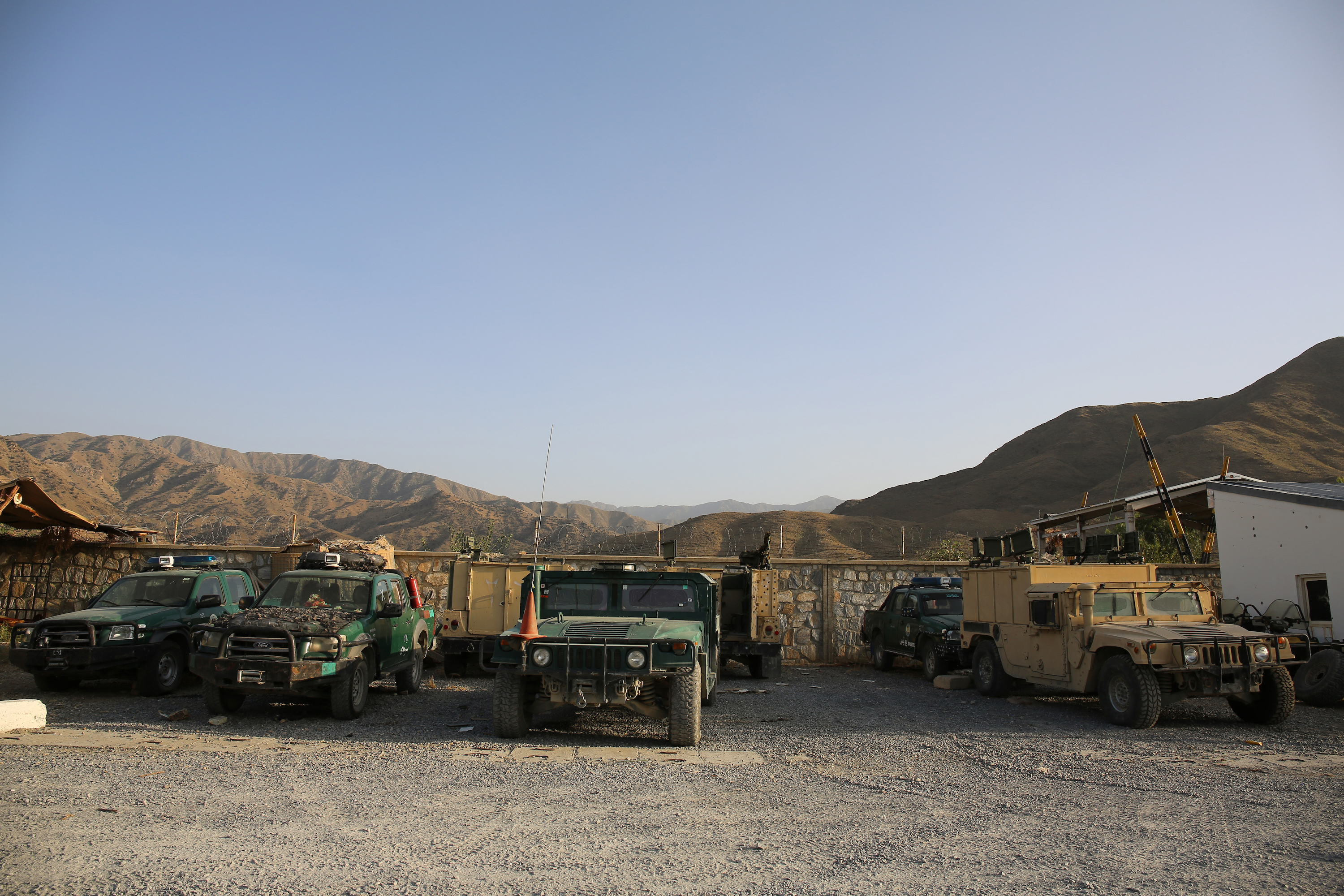The Afghan Commander Who Was Left Behind
January 4, 2023October 2020
It's late October, 2020, in one of Afghanistan’s eastern provinces. Distant puffs of smoke and a flurry of snaps overhead.
“That's the Taliban,” says a soldier, pointing to a valley between the rugged mountains.
The sporadic popping of gunfire echoes down the valley. The militia men are shooting back from a small outpost above. The soldier ducks as more bullets snap overhead—he just turned 19 and has only been fighting with the militia for two months. The seasoned commander behind him doesn’t flinch.
Hundreds of soldiers in dozens of militia units are holding outposts in the area. The Afghan National Army (ANA) and Afghan National Police (ANP) have their own outposts and larger bases, some of which were once jointly occupied by Americans. The militia’s headquarters in another district has no shortage of men, money, or weapons, but this 20-man-strong unit is struggling.
The soldiers are a mismatch of characters in worn-out high-top sneakers and ill-fitting fatigues who joined the unit at different times and have varying levels of experience. The newest members received no training and joined with their own weapons, but all were united with the same cause: to defend their villages. Most of his men have been injured, says the commander, and all have lost friends to the bitter fight.
At this stage in late 2020, the U.S.-NATO troop withdrawal from Afghanistan is well underway and levels of violence are escalating across the country.
While the U.S. packs up, Afghan forces who’d been fighting insurgent groups including the Taliban and ISIS for decades, face down an uncertain future without American support.
Now, local militias bear the lion’s share of fighting against the Taliban in many parts of eastern Afghanistan, often operating with support from the ANA and ANP. Poorly funded and poorly equipped, the militias draw their ranks from men in the local community. From each family in the area there is at least one man in the ANA, ANP or militia, one soldier said.
The commander of this unit, who remains anonymous in this story to protect his identity, leads about 150 men across dozens of outposts. He has been fighting for nearly as long as the U.S. has been in the country and he fought alongside them, sharing a base together and going on joint operations. Beyond this, they shared a personal relationship, he tells Vice World News. “We were friends and they really trusted me.”

“The enemy has stronger weapons than us,” he says. “We only have one heavy machine gun between three checkposts.” Other, more remote outposts are even less equipped, he adds.
Both enlisted men and local commanders say they felt the U.S. was leaving Afghanistan at a critical time—and pulling financial and military support just when it was needed most.
The commander says Taliban attacks are on the increase. Still, he is confident. “The Taliban can’t win, they cannot take this area from us, and the people know it,” he shouts over the music blaring out of his truck. It’s not clear if he believes his own words or is simply putting on a brave face for his men.
“It is good if they come to us,” he says with a grin, “and lay down their weapons.”
Ten months later, on August 15, 2021, Afghanistan was taken over by the Taliban. The Afghan army dissolved in days and the U.S. and coalition forces left the country in a chaotic withdrawal. Some Afghan forces were evacuated, but tens of thousands were also left behind. Some fled to neighboring countries, while others went into hiding.
Half of the men from the unit were killed in the final days of fighting.
The commander survived.

June 2022
It’s almost a year after the Taliban took control of Afghanistan and the commander looks tired, as if he aged several years.
“I have been fighting for 19 years to keep the Taliban out and I have lost many men. Now, all the blood and fighting has been for no result.”
In the weeks before the takeover, there was heavy fighting between government forces and the rapidly encroaching Taliban, says the commander. “During the day, we were stronger, but at night the Taliban were stronger. They had night vision [equipment], and we didn't.” He claims that every night as many as 12 militia soldiers across the province he manned were killed.
Just days before the Taliban swept to victory, the provincial governor had told the commander that the militias were going to resist “no matter who is surrendering across the country,’” says the commander.
But the events that quickly unfolded days later left him and his men in an impossible position, he says.
In just 10 days, the Taliban had seized the last 22 of the country’s 34 provincial capitals.
The Taliban did not have to fight their way into all of Afghanistan’s provincial capitals but rather brokered a series of surrenders.
“They never won Afghanistan. They only have it because we gave it to them,” he says.
“The surrender started from the cities, not from our checkposts in the mountains. We were strong, we had enough men and weapons, and ready to defend the country. We would have continued the fight until members were all killed, but [my boss] told me that the whole country is surrendering. And when your commander tells you to step down, there is nothing you can do.”

When he received a call from his superior at 11 p.m., telling him and his men to surrender to the Taliban, he fainted.
“I just lost control over myself, the phone fell from my hand, and I went blank for 15 minutes,” he says, shaking his head, recalling the moment.
He leans forward, wincing. “That was it…. a surrender.” He throws his hands up. “And that's when all our lives changed forever. That’s when Afghanistan changed forever.”
That night the Taliban came to his base and the commander handed over everything to them, as instructed. “I handed over the keys of my car and left the base on foot with just my scarf. It was a heartbreaking moment, we all were crying, I couldn’t sleep for the nights after and started taking sleeping medication. Even dying would be better than this, I guess.”
While they wept, and as Taliban fighters moved into Afghanistan's capital city, the nation's leader, President Ashraf Ghani, left the country along with other high-ranking government officials. Members of the Taliban were soon pictured inside the presidential palace hours later as they prepared to announce a Taliban government.
The commander says that senior officials and politicians who had property outside Afghanistan made deals to enable them to flee before the collapse. “They did not want to be detained and tortured by the Taliban like we were, so they fled before they gave the order for us to surrender,” he says.
His claims are echoed by reports that emerged earlier this year of Afghan elites and several former officials from the Western-backed Kabul government escaping to luxury condos in Dubai and beachside villas in California in the lead-up to the takeover.
As for many of those like him, who fought and led on the frontlines, the commander passes his days in hiding, afraid to venture out or seek a new job. “I have nothing to do but sit at home. If I do anything, they'll come after me again. But I can’t live hiding for the rest of my life. I have to find a way and leave.”
He says that his men are in a different situation. Most, he says, are without work but safe from the Taliban “because they did not hold senior positions,” like he did. Few have found daily work as laborers or helping out with the family business, but in most cases, the Taliban are not allowing members of the former Afghan security forces to work. “They’re following us everywhere. We cannot work or contact or visit relatives. We can’t sleep,” he says quietly.
In the aftermath of the loss, none of his soldiers were evacuated, he says.
Many of those who were not killed in the last days of fighting have fled the country, or are seeking ways to leave, he says, estimating that at least a dozen of his men have gone to Pakistan or Iran.
“More than 1,400 militia soldiers and staff were left behind,” he claims, adding that the estimate is from two districts alone.
“It’s hard to keep hope when so much time has passed.”
Present day
There are no reliable numbers of how many Afghan security forces were killed in the final weeks of fighting, but some have said it is in the thousands, with many more missing.
Today, those left behind fear being caught up in unlawful targeted killings of people whom the Taliban perceives as adversaries.
The commander wonders why he has been forgotten.
“We had an alliance and friendship with the Americans. They would call on us to join in operations because we knew the area. The American special forces trained us. At one time, we shared a base with them and they paid our salaries. They trusted us and we had a responsibility to protect those areas from Taliban or Daesh for the Americans. Now, it’s the Americans' responsibility to evacuate us.”
Today, many like the commander feel let down and used.
“Almost one month before the collapse, the head commander gave our details to the Americans and they promised that they would hire a lawyer to work for us and get us evacuated. This continued for three months, but then there was no further contact.”
Despite many promises of help, the commander himself was abandoned by the Americans. He has since been beaten by the Taliban several times.
“I was promised by the Americans to be evacuated from Afghanistan, but after the collapse, they didn’t answer me.”

It has been over a year since the Taliban’s seizing of the country. The Taliban are still not recognised internationally and by many of their own countrymen, while the soldiers left behind are lost in the crowd, hiding in homes, and beginning to believe that no one is coming back for them.
It has also been over a year since Taliban spokesman Zabihullah Mujahid promised a gentler rule.
“I would like to assure all the compatriots, whether they were translators, whether they were with military activities, or whether they were civilians, all of them have been important. Nobody is going to be treated with revenge.”
He assured that “nobody is going to knock on their door to inspect them, to ask them or to interrogate them as to who they have been working for or interpreting for…. They’re going to be safe.”
He also said thousands of soldiers have been pardoned.
Since then the Taliban has repeatedly reiterated their commitment to the general amnesty they announced. The reality, as the commander attests and other investigations show, is drastically different.
Human rights groups have accused the Taliban of carrying out widespread revenge killings, enforced disappearances, and torture of former Afghan officials, security officers, and individuals who cooperated with the departed U.S.-led military presence in Afghanistan.
A seven-month investigation by the New York Times found that nearly 500 former government workers and members of the security forces were killed or forcibly disappeared during the Taliban's first six months in power.

Since Aug. 15, the United Nations Assistance Mission in Afghanistan has documented 160 extrajudicial killings, 178 arbitrary detentions, and 56 instances of torture and ill treatment of former government and security forces and government officials by the Islamic Emirate in Afghanistan as of June 15, 2022.
The Taliban rejected the U.N. claim. "The UN secretary-general's information that hundreds of members of the previous government were killed after the rule of the Islamic Emirate is not true. After a general amnesty, no one is allowed to harm anyone," Mujahid said on Twitter.
But just three months ago, on Sept. 15, Amnesty International released a report saying that the ongoing Taliban killings indicate a pattern of attacks on ethnic minorities and members of the former security forces.
It is estimated that there are 78,000 left behind in Afghanistan.
According to advocates, as many as 265,000 Afghans and their families may have had some form of eligibility to apply for a U.S. visa because of their work with U.S. governmental and nongovernmental organizations during the past two decades. Though there is still no definite count on exactly how many.
A year since the takeover, Department of Homeland Security data shows 160,000 Afghans eligible for Special Immigrant Visas are still waiting for their applications to be processed. Each application takes an average of three years.
Just 8,000 Special Immigrant Visas for Afghans were processed and completed from September 2021 to August 2022 - averaging 725 per month, according to an August 2022 report by the Association of Wartime Allies, a nonprofit advocacy group.
As of August, of the 66,000 Afghans who had applied, a mere 123 have been approved, according to the investigative outlet Reveal.
Tens of thousands more are still stranded at military bases and refugee camps across the world as the U.S. government evaluates their cases and wrestles with logistical challenges to processing their admission.
Last summer, Secretary of State Antony Blinken promised that the U.S. commitment to Afghan allies “has no deadline.” The commander feels it has passed.
“It is easy for America to move on from Afghanistan because they are gone. But thousands of us did not just disappear as the Taliban took our places. We are still here, still alive and still breathing and unable to move on,” says the commander.
He smiles as he flips through photographs of himself draped in the Afghan flag, in sunglasses, with an RPG casually slung over his shoulder, his truck and his men behind him.
He has lost his country, his job, his purpose, and his pride, he says.
“That feels like a long time ago now.”
